The compressor pedal can be an afterthought for many players. In fact, it’s probably right up there next to tuners as far as fun goes. For many guitarists, because it doesn’t have an immediately noticeable effect in the same way something like a chorus or a delay does, the compressor just doesn’t seem all that necessary. However, the best compressor pedal can have a profound impact on tone for certain players.
What Is a Compressor Pedal & What Does It Do?
Compression is a type of effect that changes the dynamic range of an instrument. Pedals work and perform similarly to studio compression, in that they allow you to “squash” the dynamic range of a signal to make it sound more smooth and balanced.
Compression pedals tend to have the most prominent effect on clean tones. Overdriven and high-gain sounds are naturally compressed from the saturation, so usually the effect is most noticeable on clean channels. Twangy country licks and rhythmically complex funk riffs benefit from a bit of compression to help every note pop more evenly. The same can be said for legato, where players may not fret every note with the exact same power.
For a lot of players, a compressor pedal with subtle settings is an “always on” pedalboard mainstay. For others, it’s clicked on when they need a bit of a gain and/or treble boost, in addition to some more sustain and control. Everyone’s mileage varies!
How Do Guitar Compressor Pedals Work
The main parameter is the threshold, which tells the pedal at which volume to turn on. Signals above the threshold tell the compressor to kick in, while those below leave it off. The next important parameter is ratio, which tells the compressor how much to reduce the input signal. For example, a 4:1 ratio tells the pedal to let 1 dB through for every 4 dB of volume above the threshold. Compression ultimately tells the loudest parts of the signal to pipe down for a more balanced level overall.
Types of Compressor Pedals (& Their Uses)
In general, there are several different kinds of compression. When it comes to compressor pedals, you’re somewhat less likely to see the same variety that you’d see in studio outboard compression.
Here are the most common types of compression in pedals:
- VCA: Voltage Controlled Amplifier. VCAs use an IC chip with transistors that tell the pedal how much gain reduction to apply. The sound is typically described as fast, clean, and precise.
- FET: Field Effect Transistor. FETs are quite similar to VCAs, though they tend to have more character and desirable sonic qualities. Pedals marketed as FET want you to think of the iconic 1176 studio compressor, but oftentimes they sound like a VCA.
- OTA: Operational Transconductance Amplifier. OTAs use a similar chip as VCAs with main difference being their output is variable current and not voltage. The majority of compressor pedals use OTA as their foundation.
- Optical/Opto: Opto compressors like the coveted LA-2A use a light source and light-sensitive resistor to apply gain reduction. The sound is one of the most natural you’ll find in a compressor.
This is not a comprehensive breakdown of all kinds of compression, but it will give you an idea of the technology and flavors you’ll most frequently find in pedal compression.
The Best Compressor Pedal for Guitar [Our Top 12 Picks]
1. Keeley Compressor Plus – Best Overall
![The Best Compressor Pedal for Any Budget [Our Top 7 Picks]_2](https://producelikeapro.com/blog/wp-content/uploads/2022/11/The-Best-Compressor-Pedal-for-Any-Budget-Our-Top-7-Picks_2.jpg)
The Keeley Compressor is the go-to for plenty of guitar players out there. Many guitarists value its simplicity and sound quality, as well as its premium components and build quality. The four-knob design is easy to dial in, with settings for Sustain (adjusts ratio/sustain), Level (adjusts for makeup gain), Blend (wet/dry), and Tone (brightness). There’s a reason this is Keeley’s best-selling pedal.
2. Boss CP-1X Compressor – Best Value
![The Best Compressor Pedal for Any Budget [Our Top 7 Picks]_3](https://producelikeapro.com/blog/wp-content/uploads/2022/11/The-Best-Compressor-Pedal-for-Any-Budget-Our-Top-7-Picks_3.jpg)
Boss pedals, including the CP series, have history as being some of the most well built, easy to use, and affordable pedals ever made. The CP-1X is a fresh and modern take on their classic compressors, setting itself apart with Multi-Dimensional Processing. This essentially allows the pedal to analyze the guitar’s frequency spectrum and apply compression independently, a la multiband compression. It’s a powerful tool with a very simple layout that anyone can dial in appropriately.
3. TC Electronic Hyper Gravity Compressor
![The Best Compressor Pedal for Any Budget [Our Top 7 Picks]_4](https://producelikeapro.com/blog/wp-content/uploads/2022/11/The-Best-Compressor-Pedal-for-Any-Budget-Our-Top-7-Picks_4.jpg)
Part of what makes TC Electronic pedals so unique is their incredible hybrid designs utilizing digital DSP and analog circuitry. The HyperGravity is a multiband compressor pedal with a modern and clean Spectra setting, a classic Vintage mode, and a customizable TonePrint setting. With TonePrint you can actually load artist presets and make your own settings in the TonePrint Editor for Mac/Windows. This is a highly flexile compressor.
4. MXR Dyna Comp M102 – Best Under $100
![The Best Compressor Pedal for Any Budget [Our Top 7 Picks]_5](https://producelikeapro.com/blog/wp-content/uploads/2022/11/The-Best-Compressor-Pedal-for-Any-Budget-Our-Top-7-Picks_5.jpg)
If there’s anything guitarists love, it’s great tones that don’t take a ton of work. Plug-and-play is one of the most satisfying aspects of collecting awesome gear that sounds great without endless tweaking. The MXR M102 definitely falls into that category, with two-knob operation: Output (makeup gain) and Sensitivity (ratio). For a no-nonsense option, the MXR is fantastic.
5. Wampler Ego Compressor Pedal
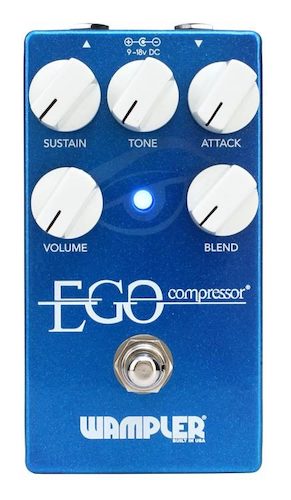
Wampler’s Ego Compressor is a flexible all-around pedal for compression and sustain. Controls include Sustain, Tone, Attack, Level, and Blend. It easily integrates into any rig and can provide any number of tone lifts, like increasing sustain, leveling out peaks, or even just thickening up the signal.
6. JHS Pulp ‘n’ Peel Compressor V4 – Best High-End Compressor Pedal
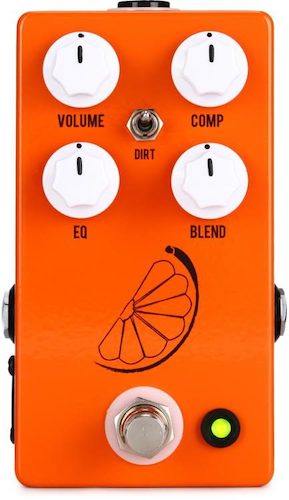
Pulp ‘n’ Peel is a classic vintage compressor in a pedal format. Unique to this pedal is the Dirt circuit that adds some grit into the tone. We’ve talked about clean this and clean that, but there’s something to a compressor pedal that adds character to your tone. This pedal is great for boosting and sustaining while squeezing the top end down a touch; still, you can always use the EQ control to bring any lost frequencies back up. It also has a built-in XLR out for bass and acoustic instruments.
7. Xotic SP Compressor Pedal – Best Mini Compressor
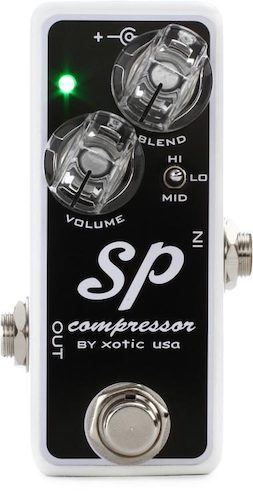
Arguably the only compressor pedal to rival the Keeley in terms of reputation is the Xotic SP Compressor. It’s based on the Ross compression circuit valued for being transparent and comes in a pedalboard-friendly mini enclosure. Settings include Volume, Blend, and a three-way switch for setting Hi, Mid, or Lo compression strength. This can easily be one of those subtle “always on” compressors, or something more aggressive for boost and sustain.
8. Origin Effects Cali76 Compact Deluxe
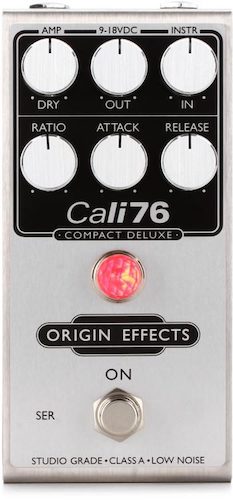
The Cali76 by Origin Effects is a studio-grade FET compressor in pedal format. As its name suggests, the design is based on the iconic UREI/Universal Audio 1176. It includes variable attack, release, and ratio, as well as input and output settings just like the original studio hardware. Every Origin pedal is handmade, and though pricey, this is an extremely high-quality pedal.
9. Orange Kongpressor Compressor Pedal

Here’s a fine example of an optical compressor by the incredible designers over at Orange. Of the more unique features included are a “Chime” control to boost or cut top-end sheen. The pedal also offers up to 12dB of clean gain boost, so this can be a super powerful tone-shaping tool rather than just a straightforward compressor.
10. Fender The Bends Compressor Pedal
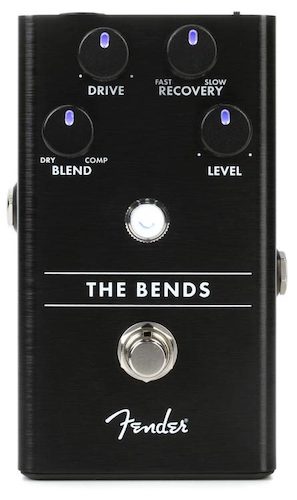
Fender unveiled their first complete pedal lineup back around 2018. This included The Bends — a natural sounding and feeling compressor pedal for guitarists. Rather than being a tone hog, The Bends strives to a gentle dynamic controller. Perhaps most importantly, it’s meant to preserve a player’s touch.
11. Darkglass Hyper Luminal Bass Compressor
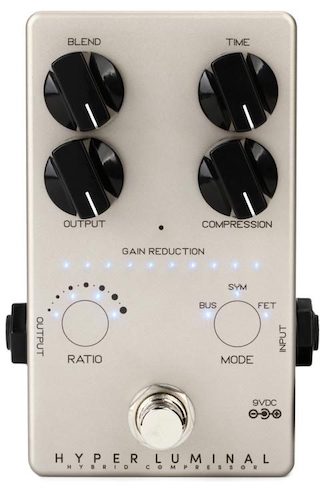
Darkglass pedals are some of the most revered bass effects and preamps currently available. The Hyper Luminal compressor for bassists packs three styles of compression: BUS (after the famous solid-state bus compressor), FET (1176), and SYM, which is based on a discontinued pedal. The coolest feature is the ability to fine-tune and access advanced features over USB using Darkglass software.
12. Walrus Audio Deep Six V3 Compressor Pedal
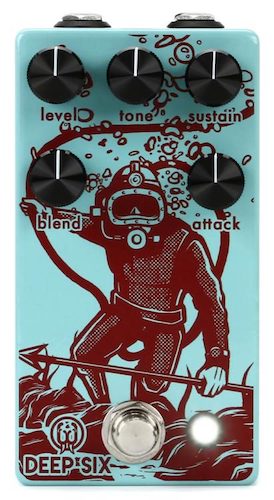
Walrus Audio makes a ton of really interesting pedals with visually striking artwork to take it over the top. The Deep Six is another FET-style compression pedal offering plenty of versatility in an easy-to-use layout. It responds well to any and all incoming signals from different styles of pickups.
Tips for Using Your Compressor to Clean Up (Or Squeeze) Your Sound
Here’s probably the most important tip for using a compressor pedal, and that’s where to put it in the signal chain. Stuff like setting the actual parameters is best left to experimentation and individual taste (as a guideline, don’t underestimate the power of the blend knob).
- RELATED: How to Use a Compressor (Easy Beginner’s Guide)
- RELATED: 8 Best Sustain Pedal Options for Keyboard & Digital Piano
Putting the compressor earlier in the signal path means it works on more of the direct sound coming from the pickups. A lot of players will put it right up front after the tuner. Putting a compressor later in the chain, after effects like modulation or time-based effects, means the compressor will also squash the output of those pedals. In many cases, especially with effects like reverb and delay, the results can be undesirable. Always remember there are no rules, but keep in mind compression works well earlier in the chain.
Advance Your Career in Music Production
Aspiring to make a mark in the music industry? The Produce Like A Pro Academy can set you on the right path with its extensive educational materials and supportive network of professionals. Here, you’ll find everything you need to master the art of audio production, from in-depth tutorials to hands-on courses.
Embrace the opportunity to learn from the best and connect with other music enthusiasts by joining our Academy today!

![The Best Compressor Pedal for Any Budget [Our Top 7 Picks]](https://producelikeapro.com/blog/wp-content/uploads/2022/11/The-Best-Compressor-Pedal-for-Any-Budget-Our-Top-7-Picks.jpg)


